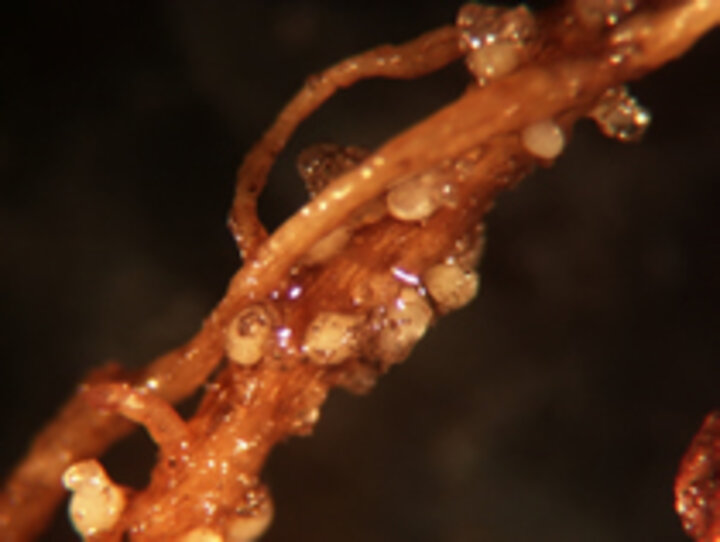Now that harvest is wrapping up, most farmers are glad that job is finished and happy with their yields. This year good management and Mother Nature converged to give most farmers above average yields. But occasionally this fall, I ran into farmers who were disappointed in their yields, particularly soybean yields. They sing what I call the “Soybean Blues!”
Average Soybean Yields
on 29 SCN-infested sites in UNL research trials:
- Resistant Varieties – 58.0 bu/ac
- Susceptible Varieties – 52.1 bu/ac
SCN has been identified in 58 Nebraska counties which produce 93% of the state's soybeans.
The song usually goes something like this,
What happened to my soybeans? They looked so good all year. But when we got to harvest, The bushels did not appear!The saddest case of the Soybean Blues I ever heard was sung by a local farmer several years ago. This is what he told me, put to verse:
My neighbor and I are good farmers.
We plant, spray and harvest together.
Yet his bean yields beat mine,
Almost every time.
And he’s NOT an eight-bushel-better farmer!
A variety of conditions could cause either of these songs to be sung, but the most common cause would be the soybean cyst nematode (SCN) — the number one yield robber for soybean growers in Nebraska and across the U.S. Last year SCN caused over $1 billion in losses for soybean growers across the country. The loss for Nebraska soybean farmers is estimated at $45 million.
When we tested the field for the farmer singing the "Soybean Blues," we found SCN in his fields. He switched to SCN-resistant varieties in his rotation and was so happy with the results he became my best advocate, encouraging his neighbors to test their fields for SCN.
Now, while those field areas that didn't yield as well as expected are still fresh in your mind — or stick out like a sore thumb on your yield maps — is the time to do something about it. Before the ground freezes, you can collect soil samples from these underperforming acres much as you would collect a surface soil sample for fertilizer recommendations.
If your crop consultant, field scout, or co-op is already collecting soil samples, ask them to take a few more soil cores and then split the sample, half for fertilizer recommendations and half for SCN analysis. You might also want them to collect these samples on corn ground that will be going to soybeans next year. If SCN is detected, you can start managing it by using resistant varieties.

SCN is a microscopic roundworm that attacks the soybean root, competing with the plant for moisture and nutrients, and causes injury sites on the roots which can increase the incidence of soil-borne diseases such as Sudden Death Syndrome (SDS) or Brown Stem Rot (BSR). The only stage of its life when SCN is visible without a microscope is when the female’s body cavity fills with eggs and they erupt through the root walls, forming the small cysts. You will have to look close because even at this stage of their life cycle, the cysts are smaller than the head of a pin.
Although the cysts can be observed on the roots during the growing season, a soil sample is the only way to determine the level of infestation in your fields. There are two good things about sampling for SCN. First, it can be done any time of the year, and second, the Nebraska Soybean Board will cover the cost of SCN analysis for your samples submitted to the University of Nebraska Plant and Pest Diagnostic Lab.
Since 2005, more than 7,600 soil samples have been processed through this program for SCN and over 30% of them came back positive. In many cases, farmers submitting the samples had no idea SCN was present in their fields.
Once SCN is identified in a field, management steps should include rotating soybeans with other crops, which most farmers were already doing, and using SCN-resistant varieties when soybeans are planted.
Research has shown an average six bushel-per-acre yield increase when planting resistant varieties in SCN-infested fields. Unlike other traits, there is no tech fee for SCN-resistance. SCN resistance results from natural breeding programs and is not a GMO.
When you add up the benefits — free SCN analysis, an average six-bushel yield increase by planting resistance in infested fields, and no increased seed cost — why wouldn’t you take time to sample for SCN this fall and adjust your soybean management accordingly for 2017?
More on SCN
For more information on SCN visit the SCN Disease Management page in the CropWatch section, Plant Disease Management for Agricultural Crops. Or, contact your local Nebraska Extension office where you can get free bags for SCN analysis.
